Abstract
Soil salinization in coastal areas is a serious problem restricting agricultural development. This field study aimed to explore the effects of flue gas desulfurization gypsum (FGDG) and coal fly ash (CFA) in combination with irrigation on coastal saline soils in China. Six different treatments (C1–C4: FGDG 4.5–15.0 t/hm2; C5 and C6: FGDG 4.5 t/hm2 combined with CFA 2.0 and 3.5 t/hm2) were established, and soil properties such as pH, electrical conductivity (EC), and organic matter (OM) content were analyzed. The results showed that compared with the control group, the addition of FGDG (4.5 t/hm2 to 15 t/hm2) slightly increased the soil pH, and the combined application of FGDG and CFA made the soil pH closer to neutral. The application of FGDG combined with two rounds of irrigation could reduce the soil EC, and the mixed application of FGDG and CFA further reduced the soil EC by about 6.7% in the 0–20 cm layer. The application of FGDG combined with irrigation showed no significant effect on the soil OM content. In general, the moderate application of FGDG and CFA can effectively improve the physicochemical properties of soil, potentially contributing to more sustainable agricultural practices in coastal regions.
1. Introduction
Soil salinization is one of the critical challenges besetting global agriculture. Owing to the long-term impacts of tidal erosion and seawater intrusion, soil salinization in coastal zones is escalating in severity []. The Leizhou Peninsula is the southernmost peninsula-type geographical unit on the Chinese mainland. This region is characterized by low-lying, flat topography (predominantly below 100 m elevation), providing the geological foundation for saline soil formation. The coastal soil salinity is dominated by Na+, Mg2+, Cl−, and SO42− in the ocean, resulting from seawater intrusion, evaporation-driven concentration, and improper irrigation practices []. This salinization induces significant degradation of soil physical properties, including increased bulk density, reduced porosity, and decreased permeability coefficients, all of which impede root development []. Additionally, high concentrations of salt ions can disrupt the uptake and balance of essential nutrients in plants and lead to deficiencies in key nutrients []. Traditional improvement approaches, including water leaching, chemical amendments, and biological strategies, are constrained by high costs and environmental risks []. Therefore, there is an urgent imperative to develop low-cost, sustainable alternatives in coastal saline regions.
As by-products of coal-fired power plants, the disposal of flue gas desulfurization gypsum (FGDG) and coal fly ash (CFA) has faced numerous challenges in recent years. It is reported that China produced approximately 140 million tons of FGDG in 2023, and nearly 20% of it has not been effectively utilized []. Furthermore, the annual output of CFA in China was as high as 827 million tons in 2021 []. However, some of the FGDG and CFA are still discarded in landfills, and an effective resource utilization system has not been established yet, which leads to a waste of resources, low efficiency in land use, and the spread of potential pollutants (sulfate constituents and heavy metals) [,]. More importantly, China vigorously advocates green development and resource recycling and has put forward higher requirements for the comprehensive utilization rate of industrial solid waste. Therefore, there is an urgent need to explore new, more environmentally friendly, efficient, and economical disposal and resource utilization approaches.
Currently, extensive research efforts have revealed the potential of FGDG and CFA for improving soil quality, particularly in saline soil [,,]. FGDG, predominantly constituted of CaSO4·2H2O, has been conclusively demonstrated to play a significant role in the remediation of sodic soils. It functions through ion exchange reactions, where Ca2+ displaces Na+ that are adsorbed onto soil colloids, effectively mitigating sodium toxicity to plants []. Shao et al. [] demonstrated that FGDG remarkably decreased the total soil salt content by 65.6% and effectively mitigated soil salinization stress and optimized soil structure, which improved the quality of winter jujube (Ziziphus jujuba Mill.) by combining Trifolium planting. Furthermore, CFA encompasses a diverse array of components, notably SiO2, Al2O3, and Fe2O3, in addition to harboring several plant-essential nutrients []. The porous microstructure characteristic of CFA endows it with the capacity to augment soil porosity and water retention capabilities []. Sajid Ansari et al. [] found that CFA provided many essential plant nutrients to the growth medium and improved some important soil properties, such as pH, electrical conductivity (EC), porosity, and water-holding capacity. However, larger application amounts (30–60 t/hm2) of FGDG resulted in a significant reduction in the plant height and biomass of oat []. Additionally, a low concentration of CFA (<20%) promoted the growth, yield, chlorophyll content, carotenoid content, and mineral content of radishes []. Based on the above discussion, the combination of FGDG and CFA may induce positive synergistic impacts for improving the physicochemical properties of saline soil. The acidic nature of FGDG can neutralize the alkaline properties of CFA, creating a more balanced chemical environment in the soil. While previous studies have demonstrated the potential of FGDG and CFA in soil improvement, they predominantly focused on inland sodic soils or single-amendment effects [,]. This study hypothesizes that the combined application of FGDG and CFA, coupled with controlled irrigation, can more effectively adjust pH and mitigate salinity in coastal chloride-rich soils by promoting ion leaching—a mechanism yet to be systematically explored in the context of Leizhou Peninsula’s tidal flat ecosystems.
To address this research gap, a field study was conducted to study the effect of FGDG/CFA addition on the coastal saline soil. We analyzed the influence of additives and irrigation times on soil properties, including pH, EC, salt content, and organic matter (OM) content. Considering the disruption of excessive additives to soil ion balance, osmotic stress, and biomass planting, the primary aim of our research was to empirically determine whether moderate applications (<15 t/hm2) of FGDG and CFA could effectively improve coastal saline soil through field investigation. This study aims to scientifically validate the synergistic effects of FGDG and CFA amendments on saline soil rehabilitation, with the ultimate goal of providing an economically viable and environmentally friendly solution for coastal soil improvement and promoting sustainable agricultural development.
2. Materials and Methods
2.1. Location and Feedstocks
The area of coastal tidal flats is approximately 100,000 hm2 in Zhanjiang City, Guangdong Province, and there are about 40,000 hm2 of coastal saline land []. The experimental field was located in Leigao Town, Leizhou City, on the northeast side of the village. On one side of the experimental field was an irrigation canal, and on the other three sides were paddy fields (Figure 1a–c). The experimental field measured about 9.5 m × 11.7 m and was divided into six independent and randomized experimental areas to conduct the field experiment (Figure 1d). Additionally, we collected soil samples from a farmland located 5 km away for comparative analysis of soil properties. FGDG and CFA were from the coal-fired power plant in Leizhou. Table 1 shows the basic characteristic parameters of FGDG and CFA.
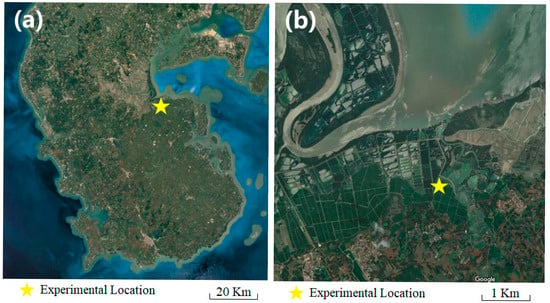
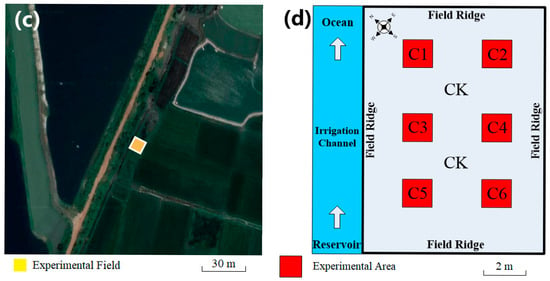
Figure 1.
Photos of the location ((a): 20 km; (b): 1 km; (c): 30 m) and the division diagram (d) of the experimental field.

Table 1.
The basic characteristic parameters of FGDG and CFA.
2.2. Field Trial
Six different treatments were used to investigate the influence of FGDG/CFA on coastal saline soil properties (Table 2). Based on the previous experience [,], C1, C2, C3, and C4 were designed to investigate the influence of FGDG amount (4.5, 7.5, 10.5, and 15 t/hm2) on soil properties. C5 and C6 were used to investigate the influence of FGDG combined with different CFA amounts (2.0 t/hm2 and 3.5 t/hm2) on soil properties. Upon the application of FGDG and CFA, a profound tillage procedure was carried out on the soil layer spanning from 0 to 20 cm in depth. The soil samples were collected from three depth layers (0–20, 20–40, and 40–60 cm) after a 60-day period following FGDG and CFA application based on the previous experience []. In addition, two rounds of irrigation were performed. Specifically, each successive irrigation using local tap water was scheduled at precise 24 h intervals. This interval was determined based on a soil infiltration coefficient of 0.22 m/d, measured using a soil infiltration meter. Prior to each irrigation instance, a combination of a probing instrument and a shovel was employed to drill sampling holes and extract soil samples. These samples were then reserved and designated for subsequent analytical investigations.

Table 2.
Experimental design plan.
2.3. Analysis Methods
The basic properties of the saline soils were tested after samples were taken five times and mixed in each treatment area. The pH of the soil was measured with a pH meter (PHS-3E, INESA, Shanghai, China) using a 1:2.5 solid-to-water ratio as specified in the Chinese standard NY/T 1377-2007 []. The EC value was measured with a conductometer (DDS-11A, INESA, Shanghai, China) using a 1:5 solid-to-water ratio as specified in the Chinese standard HJ 802-2016 []. The OM content was measured by a colorimetric method using a high-precision soil fertilizer nutrient meter (YT-TRX04, YUNTANG, Weifang, Shandong, China). The Na+ concentration of the soil was determined with an inductively coupled plasma-optical emission spectrometer (ICP-OES, PLASMA3000, NCSMB, Beijing, China) after the digestion using a mixture of 5 mL HCl and 20 mL HNO3. The Cl− concentration of the soil was determined with an ion chromatograph (ICS-600, ThermoFisher, Waltham, MA, USA) after the digestion using a mixture of 5 mL HNO3, 3 mL H2O2, and 3 mL HF. The concentrations of alkali and heavy metals were analyzed by ICP-OES after the digestion. The soil permeability coefficient was determined using a soil infiltration meter (MH-TR 1.0, HUAMAO, Changchun, Jilin, China). The infiltration ring was vertically inserted into the soil to a depth of 10–15 cm, with water slowly added to the preset level. After a 5–10 min waiting period for initial soil wetting, the ring was refilled to the baseline level, and water level declines were recorded at specified time intervals. Total water-soluble salt was measured according to the Chinese standards (NY/T 1121.16-2006) [].
3. Results and Discussion
3.1. Physicochemical Properties of Experimental Fields
The physicochemical properties of the surface soil showed significant differences between the experimental soil and the surrounding planting soil in several key indicators (Table 3). Compared with untreated soil, the experimental soil was more neutral in pH, had higher EC (indicating more soluble salts), and richer OM. However, the concentrations of Na+ and Cl− in the experimental soil were 8.0 times higher than those in the untreated field, which may have an adverse impact on plant growth. The soil property in the experimental field was predominantly clay, with a low permeability coefficient. The comparison of the total water-soluble salt content also highlights the problem of excessive salinity in the experimental soil. Therefore, the improvement of experimental fields is different from typical saline-alkali land in northwest China, and the focus should be on reducing soil salinity and improving soil permeability [].

Table 3.
Comparison of the properties of experimental soil at 0–20 cm and the surrounding planting soil.
The fundamental indicators at varying depths within saline soils are illustrated in Figure 2. The average pH value of the soil was 6.79, exhibiting a slight upward trend as the depth increased. The spatial distribution of soil pH values was uniform according to a coefficient of variation as low as 0.3%. The average EC value of the soil reached 2047 μS/cm and presented a negative correlation with soil depth. The change in soil EC was relatively stable with a variation coefficient of 4.2%, suggesting a relatively uniform distribution of soil salinity. The organic matter content at the surface layer, ranging from 0 to 20 cm, was significantly higher than that of the deeper layers of 20 to 40 cm and 40 to 60 cm. The variation in organic matter with depth was pronounced compared with other indicators, and the relatively higher organic matter content in the surface layer was due to the long-term accumulation of plant litter []. These data on soil characteristics provide crucial bases for understanding soil quality and guiding subsequent soil improvement and utilization work.

Figure 2.
(a) pH, (b) EC, and (c) OM content of experimental saline soils at different depths.
3.2. Effects of FGDG Addition and Irrigation on Soil Properties
3.2.1. Soil pH
As the amount of FGDG increased gradually from 0 t/hm2 to 15.0 t/hm2, the pH of soil at 0–20 cm showed a gradual increasing trend, increasing from 6.73 to 6.87 (Figure 3a). The pH of the surrounding planting soil was determined to be 5.6 (Table 3). The high pH of experimental soil might be related to continuous rainfall and the low terrain of the experimental field. Although the pH (6.3) of FGDG was lower than that of the experimental soil, irrigation eliminated the inherent effects of FGDG, mainly because the ion exchange reactions changed the acid-base balance of the soil []. The increase in soil pH after FGDG treatment has also been observed in raised beds []. The pH variation associated with soil depth was mainly concentrated in the 0–20 cm surface layer after the addition of 4.5 t/hm2 FGDG, while the pH of the lower soil remained basically unchanged (Figure 3b). Moderate and surface application of FGDG could not significantly affect the pH value of deep soil. These results have also been verified in other studies [,].
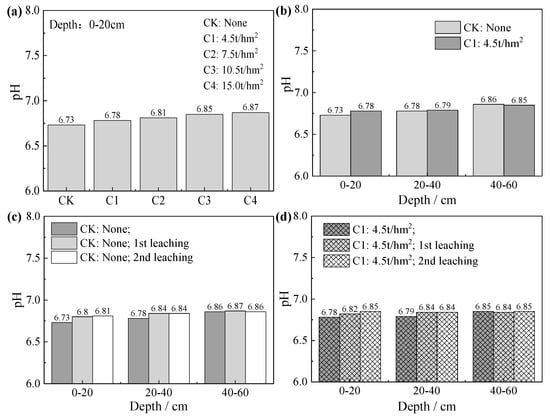
Figure 3.
Impacts of improvement conditions: (a) effects of FGDG amount on soil pH; (b) effects of FGDG addition on soil pH at different depths; (c,d) effects of irrigation time on soil pH.
The effects of irrigation frequency on soil pH are depicted in Figure 3c,d. For both the control group and the treatment group with a FGDG addition of 4.5 t/hm2, as the irrigation frequency increased, the influence on pH variations at different soil depths gradually diminished. After two rounds of irrigation, the effect of irrigation became negligible, irrespective of gypsum application. The soil pH maintained a certain stability during multiple irrigations, which could be attributed to the fact that the combined effect of the buffer performance of the soil itself and the relatively stable acid-base system formed []. Overall, the pH of coastal saline-sodic soil with FGDG addition was close to neutral and suitable for the planting of most crops [].
3.2.2. Soil EC
Soil EC is an important indicator reflecting the content of soluble salts; the concentration of ions in the soil solution, and the overall fertility and health status of the soil []. As the FGDG application rate increased incrementally from 0 t/hm2 to 15.0 t/hm2, the EC of the 0–20 cm soil layer exhibited a decreasing trend, dropping from 2378 μS/cm to 2045 μS/cm (Figure 4a). Although the application of FGDG to soil resulted in the formation of new salt species, the natural leaching process and efficient soil drainage caused a reduction in EC []. The impact of FGDG addition on soil EC was predominantly observed in the 0–20 cm surface layer, whereas the EC of deeper soil layers exhibited no significant variation (Figure 4b). This phenomenon can be attributed to the fact that FGDG is primarily applied to the 0–20 cm layer of soil.
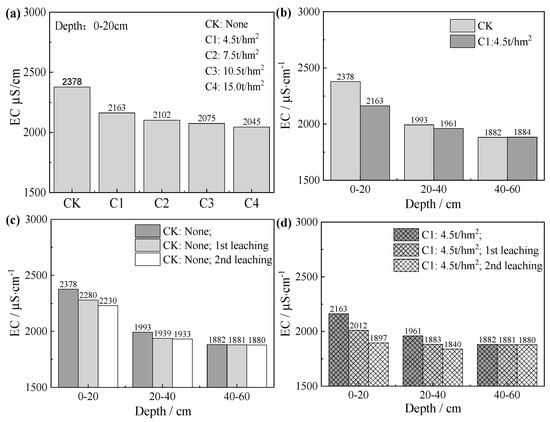
Figure 4.
Impacts of improvement conditions: (a) effects of FGDG amount on soil EC; (b) effects of FGDG addition on soil EC at different depths; (c,d) effects of irrigation time on soil EC.
The effects of irrigation frequency on soil pH are depicted in Figure 4c,d. For both the control group and the treatment group with a FGDG addition of 4.5 t/hm2, as the number of irrigations increased, the EC of soil at different depths exhibited a discernible decrease. At a depth of 0–20 cm, the EC of the control group decreased from 2378 μS/cm to 2230 μS/cm after twice irrigations. The cumulative effect of successive irrigations facilitated soil ion leaching and balanced ionic concentrations, thereby alleviating soil salinity. []. More specifically, the EC of soil with adding 4.5 t/hm2 decreased by 12.3% (2163 μS/cm to 1897 μS/cm) after the twice irrigation, which was better than the irrigation effect (2378 μS/cm to 2230 μS/cm) in the control group. However, as the soil depth increased, the positive impact of irrigation became weak, and there was basically no EC variation at the depth of 40–60 cm. In addition, the fitting analysis revealed that there was a strong correlation between soil EC and salinity, conforming to the equation (salt content = 0.00339 × EC − 0.1656), where the correlation coefficient R2 = 0.98 (Figure 5). Similar relationships have also been reported in a previous research []. Scientifically, this model capitalizes on the linear correlation between EC and salt content, validated via preliminary calibrations in the target coastal soils dominated by Na+ and Cl− ions. This approach not only enhances data comparability but also facilitates field-scale implementation of the amendment techniques.
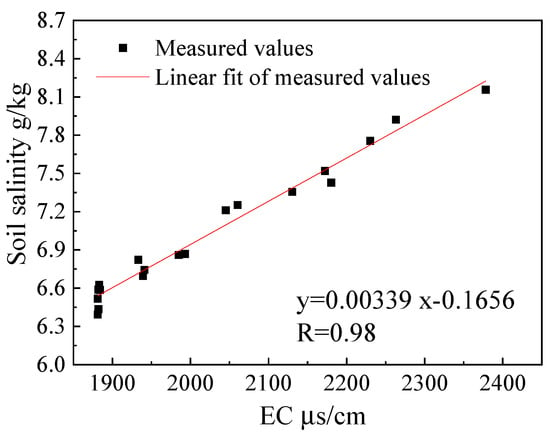
Figure 5.
Relationship between soil salinity and EC.
3.2.3. Soil OM Content
As the FGDG application rate increased incrementally from 0 t/hm2 to 15.0 t/hm2, the OM content of the 0–20 cm soil layer presented a relatively small overall variation range. (Figure 6a). This is because OM primarily originates from animal and plant residues, microorganisms, and their secretions [], and the FGDG addition containing CaSO4 does not directly influence the soil OM. In accordance with the soil distribution, the OM content exhibited a decreasing trend as the depth increased, and the majority of soil OM was within a depth of 0–20 cm (Figure 6b). Moreover, the addition of FGDG did not alter this distribution pattern of soil OM. The effects of irrigation time on soil OM content are depicted in Figure 6c,d. For both the control group and the treatment group with FGDG addition (4.5 t/hm2), as the number of irrigations increased, the OM content of soil at different depths showed an insignificant variation. In summary, the application of FGDG and irrigation had no significant effect on the OM content of the soil.
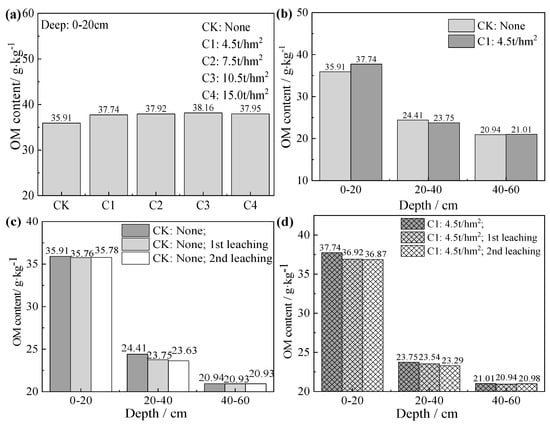
Figure 6.
Impacts of improvement conditions: (a) effects of FGDG amount on soil OM content; (b) effects of FGDG addition on soil OM content at different depths; (c,d) effects of irrigation time on soil OM content.
3.3. Effects of the Combined Application of FGDG and CFA on Soil Properties
Figure 7 illustrates the impacts of the combined application of FGDG and CFA on soil properties. As the application amount of CFA increased, the soil pH value showed an upward trend. CFA is generally weakly alkaline (pH = 8.6), and its metal oxides can react with acids in the soil, neutralizing acidic substances (Equations (1)–(3)) and thus increasing the soil pH []. Compared with the group treated with individual FGDG, the soil in the combined treatment group was closer to neutral (6.98–7.04). Compared with the individual application of FGDG, the addition of CFA further reduced the EC of the soil at the 0–20 cm layer by 6.7%. This effect was reflected by the changes in EC in different soil layers and weakened with the increase in soil depth. This is mainly due to the fact that CFA can improve soil permeability and enhance the salt leaching effect []. Moreover, the EC of soils at different depths decreased accordingly after two irrigations. After adding FGDG combined with CFA and two rounds of irrigation (48 h), the soil salinity at 0–20 cm was significantly reduced by 11.2%. These results reflect the positive impacts of improvement measures on saline soil properties at different stages.
CaO + 2H+ → Ca2+ + H2O
CaO + H2CO3 → CaCO3 + H2O
CaO + 2R-COOH → (R-COO)2Ca + H2O
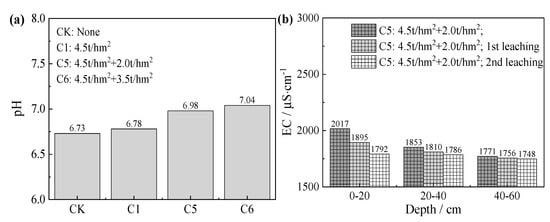
Figure 7.
Impacts of improvement conditions: (a) effects of CFA amount on soil pH; (b) effects of irrigation time on soil EC under the combined application of FGDG and CFA.
4. Conclusions
This study explored the effects of FGDG and CFA on coastal saline soil in the Leizhou Peninsula. Results showed that the application of FGDG and CFA effectively adjusted soil pH, and their combined application made the soil pH closer to neutral. The addition of FGDG and irrigation reduced soil EC, and the combined application of FGDG and CFA further decreased the EC of the 0–20 cm soil layer by 6.7%, significantly reducing soil salinity by 11.2% after two irrigations. However, FGDG and irrigation had little to no discernible effect on soil OM content. Overall, the moderate application of FGDG and CFA can improve the physicochemical properties of coastal saline-sodic soil, offering a practical approach for improving coastal saline soils and promoting sustainable coastal agriculture.
Future research should focus on the following key areas: long-term monitoring of soil quality to assess treatment durability, evaluation of crop growth impacts (yield, quality, nutrient uptake, and economic viability), and exploration of soil ecosystem effects (microbial communities, biodiversity, nutrient cycling, and heavy metal pollution). This holistic approach will facilitate the development of sustainable strategies for coastal saline soil management.
Author Contributions
Methodology, J.Z. and W.L.; Software, D.H. and L.Z.; Formal analysis, X.W.; Investigation, J.Z. and H.W.; Resources, X.W. and L.Z.; Data curation, D.H., H.W. and W.L.; Writing—original draft, L.Z. and W.L. All authors have read and agreed to the published version of the manuscript.
Funding
This research received no external funding.
Data Availability Statement
The original contributions presented in this study are included in the article. Further inquiries can be directed to the corresponding author.
Conflicts of Interest
Authors Dawei Hou and Xin Wang were employed by the company China Datang Corporation Science and Technology General Research Institute Co., Ltd. Author Jingnan Zhang was employed by the company Guangdong Datang International Leizhou Power Generation Co., Ltd. The remaining authors declare that the research was conducted in the absence of any commercial or financial relationships that could be construed as a potential conflict of interest. The companies had no role in the design of the study; in the collection, analyses, or interpretation of data; in the writing of the manuscript, or in the decision to publish the results.
References
- Pereira, C.S.; Lopes, I.; Abrantes, I.; Sousa, J.P.; Chelinho, S. Salinization effects on coastal ecosystems: A terrestrial model ecosystem approach. Philos. Trans. R. Soc. B 2019, 374, 20180251. [Google Scholar] [CrossRef] [PubMed]
- Herbert, E.R.; Boon, P.; Burgin, A.J.; Neubauer, S.C.; Franklin, R.B.; Ardón, M.; Hopfensperger, K.N.; Lamers, L.P.M.; Gell, P. A global perspective on wetland salinization: Ecological consequences of a growing threat to freshwater wetlands. Ecosphere 2015, 6, 1–43. [Google Scholar] [CrossRef]
- Shokri, N.; Hassani, A.; Sahimi, M. Multi-Scale Soil Salinization Dynamics From Global to Pore Scale: A Review. Rev. Geophys. 2024, 62, e2023RG000804. [Google Scholar] [CrossRef]
- Munns, R. Comparative physiology of salt and water stress. Plant Cell Environ. 2002, 25, 239–250. [Google Scholar] [CrossRef]
- Cuevas, J.; Daliakopoulos, I.N.; del Moral, F.; Hueso, J.J.; Tsanis, I.K. A Review of Soil-Improving Cropping Systems for Soil Salinization. Agronomy 2019, 9, 295. [Google Scholar] [CrossRef]
- Wang, H.; Wang, F.; Qin, W.; He, C.; Wang, F.; Liang, X.; Li, X. A critical review on the use of flue gas desulfurization gypsum to ameliorate saline-alkali soils and its prospect for reducing carbon emissions. Sci. Total Environ. 2024, 945, 174053. [Google Scholar] [CrossRef]
- Geng, J.; Niu, S.; Han, K.; Wang, Y.; Zhu, J.; Yang, Z.; Liu, J.; Zhang, H.; Sun, X.; Liang, B.; et al. Properties of artificial lightweight aggregates prepared from coal and biomass co-fired fly ashes and sewage sludge fly ash. Ceram. Int. 2024, 50, 28609–28618. [Google Scholar] [CrossRef]
- Liu, S.; Liu, W.; Jiao, F.; Qin, W.; Yang, C. Production and resource utilization of flue gas desulfurized gypsum in China—A review. Environ. Pollut. 2021, 288, 117799. [Google Scholar] [CrossRef]
- Luo, Y.; Wu, Y.; Ma, S.; Zheng, S.; Zhang, Y.; Chu, P.K. Utilization of coal fly ash in China: A mini-review on challenges and future directions. Environ. Sci. Pollut. Res. 2021, 28, 18727–18740. [Google Scholar] [CrossRef]
- Shaheen, S.M.; Hooda, P.S.; Tsadilas, C.D. Opportunities and challenges in the use of coal fly ash for soil improvements—A review. J. Environ. Manag. 2014, 145, 249–267. [Google Scholar] [CrossRef]
- Wang, J.; Yang, P. Potential flue gas desulfurization gypsum utilization in agriculture: A comprehensive review. Renew. Sustain. Energy Rev. 2018, 82, 1969–1978. [Google Scholar] [CrossRef]
- Amezketa, E.; Aragüés, R.; Gazol, R. Efficiency of Sulfuric Acid, Mined Gypsum, and Two Gypsum By-Products in Soil Crusting Prevention and Sodic Soil Reclamation. Agron. J. 2005, 97, 983–989. [Google Scholar] [CrossRef]
- Shao, Q.; Xia, X.; Li, G.; Li, H.; Lin, J.; Lou, Y.; Yang, Q.; Wang, H.; Yang, Z.; Pan, H.; et al. Effects of flue gas desulfurization gypsum and clover planting on qualities of soil and winter jujube in coastal saline-alkali orchard of north China. Soil Ecol. Lett. 2024, 6, 230185. [Google Scholar] [CrossRef]
- Yunusa, I.A.M.; Manoharan, V.; Odeh, I.O.A.; Shrestha, S.; Skilbeck, C.G.; Eamus, D. Structural and hydrological alterations of soil due to addition of coal fly ash. J. Soils Sediments 2011, 11, 423–431. [Google Scholar] [CrossRef]
- Sajid Ansari, M.; Ahmad, G.; Khan, A.A.; Mohamed, H.I.; Elhakem, A. Coal fly ash and nitrogen application as eco-friendly approaches for modulating the growth, yield, and biochemical constituents of radish plants. Saudi J. Biol. Sci. 2022, 29, 103306. [Google Scholar] [CrossRef]
- Li, Y.; Xu, Q.; Li, G. Research on the effect of oat growth by using desulfurized gypsum and mildly improving alkaline soil. J. Baicheng Norm. Univ. 2018, 32, 1–5. [Google Scholar]
- Xuming, W.; Xiaxia, Z.; Jingyang, C.; Bolin, Z.; Hao, Y.; Xiaolin, H.; Panpan, W.; Su, M.; Hongkai, Z. The Precise Development of Saline-Alkali Soil and the Prospect of High-Efficiency Cultivation of Sea Rice Resistant to Saline-Alkali in Zhanjiang. Chin. J. Trop. Agric. 2018, 38, 25–29. [Google Scholar]
- Mao, Y.; Li, X. Amelioration of flue gas desulfurization gypsum on saline-sodic soil of tidal flats and its effects on plant growth. China Environ. Sci. 2016, 36, 225–231. [Google Scholar]
- Li, S.; Wang, C.; Huang, H.; Zhao, L.; Cao, J.; Wang, B. Vermicompost and flue gas desulfurization gypsum addition to saline-alkali soil decreases nitrogen losses and enhances nitrogen storage capacity by lowering sodium concentration and alkalinity. J. Environ. Manag. 2024, 368, 122156. [Google Scholar] [CrossRef]
- NY/T 1377-2007; Determination of pH in Soil. China Agricultural Press: Beijing, China, 2007.
- HJ 802-2016; Soil Quality—Determination of Conductivity—Electrode Method. China Environmental Science Press: Beijing, China, 2016.
- NY/T 1121.16-2006; Soil Testing Part 16: Method for Determination of Total Water-Soluble Salt. China Agricultural Press: Beijing, China, 2006.
- Nan, L.; Guo, Q.; Cao, S.; Zhan, Z. Diversity of bacterium communities in saline-alkali soil in arid regions of Northwest China. BMC Microbiol. 2022, 22, 11. [Google Scholar] [CrossRef]
- Knebl, L.; Leithold, G.; Schulz, F.; Brock, C. The role of soil depth in the evaluation of management-induced effects on soil organic matter. Eur. J. Soil Sci. 2017, 68, 979–987. [Google Scholar] [CrossRef]
- Tao, J.; Linhong, W.; Wei, G.; Hua, Z.; Xu, Y. Effects of continuous application flue-gas desulfurization gypsum and brackish ice on soil chemical properties and maize growth in a saline soil in coastal area of China. Soil Sci. Plant Nutr. 2019, 65, 82–89. [Google Scholar] [CrossRef]
- Wang, Y.; Wang, Z.; Liang, F.; Jing, X.; Feng, W. Application of flue gas desulfurization gypsum improves multiple functions of saline-sodic soils across China. Chemosphere 2021, 277, 130345. [Google Scholar] [CrossRef] [PubMed]
- Zhao, Y.; Wang, S.; Li, Y.; Zhuo, Y.; Liu, J. Effects of straw layer and flue gas desulfurization gypsum treatments on soil salinity and sodicity in relation to sunflower yield. Geoderma 2019, 352, 13–21. [Google Scholar] [CrossRef]
- Hu, A.; Yu, Z.; Liu, X.; Gao, W.; He, Y.; Li, J. The effects of irrigation and fertilization on the migration and transformation processes of main chemical components in the soil profile. Environ. Geochem. Health 2019, 41, 2631–2648. [Google Scholar] [CrossRef]
- Smith, J.L.; Doran, J.W. Measurement and Use of pH and Electrical Conductivity for Soil Quality Analysis. Methods Assess. Soil Qual. 1997, 49, 169–185. [Google Scholar]
- Su, K.; Mu, L.; Zhou, T.; Kamran, M.; Yang, H. Intercropped alfalfa and spring wheat reduces soil alkali-salinity in the arid area of northwestern China. Plant Soil 2024, 499, 275–292. [Google Scholar] [CrossRef]
- Ismayilov, A.I.; Mamedov, A.I.; Fujimaki, H.; Tsunekawa, A.; Levy, G.J. Soil salinity type effects on the relationship between the electrical conductivity and salt content for 1:5 soil-to-water extract. Sustainability 2021, 13, 3395. [Google Scholar] [CrossRef]
- Kögel-Knabner, I. The macromolecular organic composition of plant and microbial residues as inputs to soil organic matter. Soil Biol. Biochem. 2002, 34, 139–162. [Google Scholar] [CrossRef]
- Ansari, M.S.; Ahmad, G.; Khan, A.A.; Mohamed, H.I. Coal fly ash application as an eco-friendly approach for modulating the growth, yield, and biochemical constituents of Withania somnifera L. plants. Environ. Sci. Pollut. Res. 2023, 30, 87958–87980. [Google Scholar] [CrossRef]
- Zhou, W.; Li, S.; Zou, R.; Sun, X. Effect of Coal Fly Ash and Green Waste Compost on Salt Ions Leaching in Coastal Saline Soils. Pol. J. Environ. Stud. 2024, 33, 5497–5505. [Google Scholar] [CrossRef] [PubMed]
Disclaimer/Publisher’s Note: The statements, opinions and data contained in all publications are solely those of the individual author(s) and contributor(s) and not of MDPI and/or the editor(s). MDPI and/or the editor(s) disclaim responsibility for any injury to people or property resulting from any ideas, methods, instructions or products referred to in the content. |
© 2025 by the authors. Licensee MDPI, Basel, Switzerland. This article is an open access article distributed under the terms and conditions of the Creative Commons Attribution (CC BY) license (https://creativecommons.org/licenses/by/4.0/).